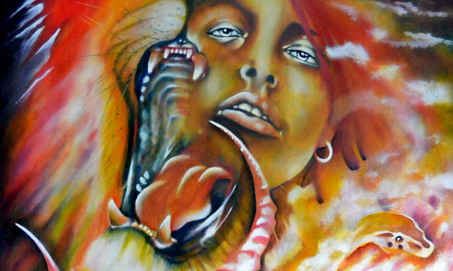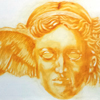
Atavistic Memories
Atavistic Memories or Palimpsest as Symbolic of Reincarnation
Atavistic Memories, oil on wood, 48 inches by 24 inches, 2014.
The term “atavistic” refers to the reappearance of a trait or behaviour absent for several generations in a family or group. It can also relate to the recurrence of an ancestral characteristic in an individual organism. In a broader sense, “atavistic” can be used to describe something primal or ancestral that resurfaces in a modern context.

The painting Atavistic Memories depicts a male figure experiencing a resurgence of traits from his ancestral past, reaching back to the ancient origins of humanity. The concept of atavism refers to the re-emergence of ancestral traits in an individual, and this painting illustrates this phenomenon through symbolism. The figure displays behaviours and characteristics from different historical epochs, suggesting a deep connection to his ancestry. The painting explores themes related to shamanism, psychedelic experiences, creative dreaming, and transformational psychology.
Atavistic could be understood as a palimpsest, lending a deeply symbolic interpretation suggestive of reincarnation.
The painting was first shown at the Doorways to the Underworld exhibition. Stevens Square Center for the Arts, on October 25th, 2014
For related information see Dream Language
Artists considered influenced by atavistic themes, particularly in the Symbolist Fin de siècle art movement in France, include:
Jean Delville, Fernand Knopff, Felicien Rops, Jan Toorop, Puvis de Chavannes, Odilon Redon, Stéphane Mallarmé and Gustave Moreau.
The English artist Austin Osman Spare also reflects atavistic influences in his work.
Original painting available from Saatchi Art

Leave a comment